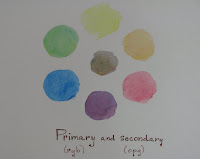Summer Camp 2010
This is a very simple lesson in creating a color wheel using the three primaries: red, blue and yellow. Check out the following sites for some great information on the basics of primary, secondary, tertiary, complimentary and analogous colors:
Arty Factory (click here to view)
Middle School Color Theory Projects (click here to view)
Lesson Plans Page (click here to view)
To make an easy, no mess, color wheel you will need:
• Red, Blue and Yellow water-soluble color pencils (We used Caran'dache supracolor — carmine red, sapphire blue and yellow to make the samples shown.)
• a small dish of water
• a paintbrush
• water color paper
Helpful Hints:
• To create a consistent paint blending we laid down the lighter color first, with the darker on top.
• After all the colors have been drawn with the pencil, lightly brush water onto the circles. Like magic you will see a watercolor painting emerge.
• After completing a color wheel, have the children try sketching out a grid of squares. Then with their three pencils, create paintings incorporating all the color combinations they learned with their wheel. (Try some with only secondary colors, some with one primary and 2 secondary, 2 complimentaries, etc. There are many variations on this theme — let them have some fun exploring!)
• If you want the children to understand tints and shades of colors, you can give them a White pencil to mix with. (Tints are the hues (colors) with white added. Shades are the hues with black added.






